Power Hungry (50 page)
Authors: Robert Bryce
Export Import Bank of the United States
Federal Energy Regulatory Commission
Northwest Power and Conservation Council
Nuclear Regulatory Commission
Overseas Private Investment Corporation
Tennessee Valley Authority
U.S. Agency for International Development
U.S. Commodity Futures Trading Commission
U.S. Environmental Protection Agency
U.S. International Trade Commission
U.S. Nuclear Waste Technical Review Board
U.S. Securities and Exchange Commission
Congressional CommitteesHouse Agriculture
House Appropriations
House Armed Services
House Budget
House Energy and Commerce
House Foreign Affairs
House Homeland Security
House Natural Resources
House Oversight and Government Reform
House Rules Committee
House Science and Technology
House Select Committee on Energy Independence and Global Warming
House Transportation and Infrastructure
House Ways and Means
Senate Agriculture
Senate Appropriations
Senate Armed Services
Senate Budget
Senate Commerce, Science and Transportation
Senate Energy and Natural Resources
Senate Environment and Public Works
Senate Finance
Senate Foreign Relations
Senate Homeland Security and Government Affairs
Senate Select Committee on Indian Affairs
APPENDIX D: COUNTRIES RANKED BY PRIMARY ENERGY CONSUMPTION, 2007 325
TABLE D.1
World's Most Coal-Dependent Countries
World's Most Coal-Dependent Countries
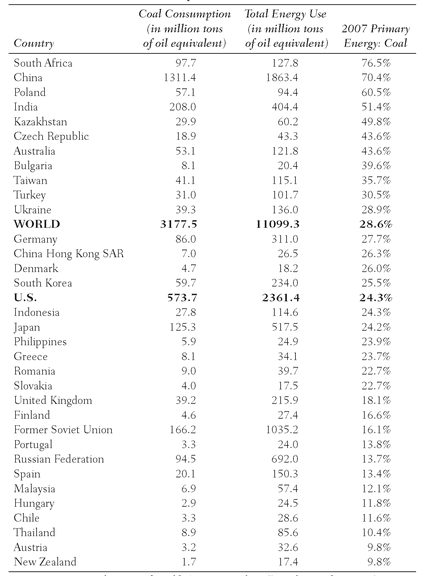
Source
: BP Statistical Review of World Energy 2008,
http://www.bp.com/liveassets/bp_internet/globalbp/globalbp_uk_english/reports_and_publications/statistical_energy_review_2008/STAGING/local_assets/downloads/pdf/statistical_review_of_world_energy_full_review_2008.pdf
.
: BP Statistical Review of World Energy 2008,
http://www.bp.com/liveassets/bp_internet/globalbp/globalbp_uk_english/reports_and_publications/statistical_energy_review_2008/STAGING/local_assets/downloads/pdf/statistical_review_of_world_energy_full_review_2008.pdf
.
Â
TABLE D.2
World's Most Oil-Dependent Countries
World's Most Oil-Dependent Countries
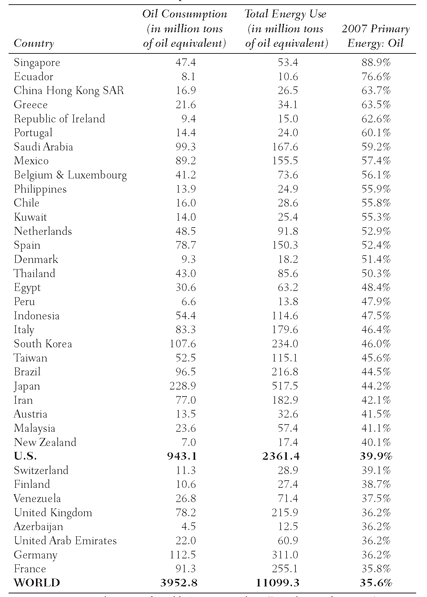
Source
: BP Statistical Review of World Energy 2008,
http://www.bp.com/liveassets/bp_internet/globalbp/globalbp_uk_english/reports_and_publications/statistical_energy_review_2008/STAGING/local_assets/downloads/pdf/statistical_review_of_world_energy_full_review_2008.pdf
.
: BP Statistical Review of World Energy 2008,
http://www.bp.com/liveassets/bp_internet/globalbp/globalbp_uk_english/reports_and_publications/statistical_energy_review_2008/STAGING/local_assets/downloads/pdf/statistical_review_of_world_energy_full_review_2008.pdf
.
Â
TABLE D.3
World's Most Natural GasâDependent Countries
World's Most Natural GasâDependent Countries
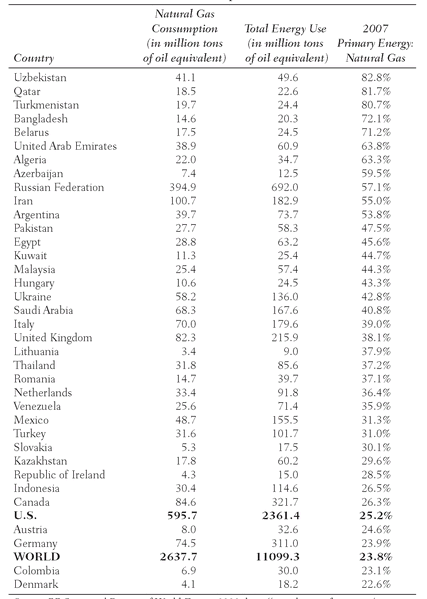
Source
: BP Statistical Review of World Energy 2008,
http://www.bp.com/liveassets/bp_internet/globalbp/globalbp_uk_english/reports_and_publications/statistical_energy_review_2008/STAGING/local_assets/downloads/pdf/statistical_review_of_world_energy_full_review_2008.pdf
.
: BP Statistical Review of World Energy 2008,
http://www.bp.com/liveassets/bp_internet/globalbp/globalbp_uk_english/reports_and_publications/statistical_energy_review_2008/STAGING/local_assets/downloads/pdf/statistical_review_of_world_energy_full_review_2008.pdf
.
Â
TABLE D.4
World's Most Nuclear-Dependent Countries
World's Most Nuclear-Dependent Countries
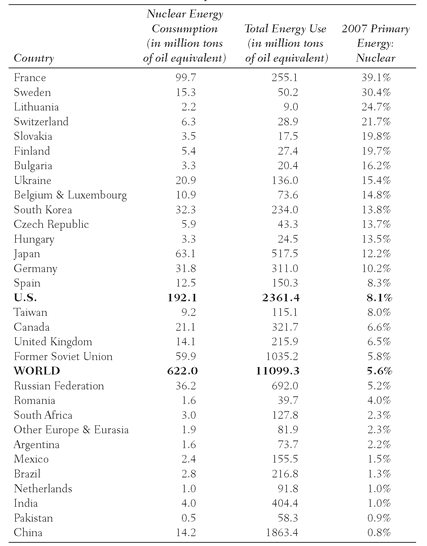
Source
: BP Statistical Review of World Energy 2008,
http://www.bp.com/liveassets/bp_internet/globalbp/globalbp_uk_english/reports_and_publications/statistical_energy_review_2008/STAGING/local_assets/downloads/pdf/statistical_review_of_world_energy_full_review_2008.pdf
.
: BP Statistical Review of World Energy 2008,
http://www.bp.com/liveassets/bp_internet/globalbp/globalbp_uk_english/reports_and_publications/statistical_energy_review_2008/STAGING/local_assets/downloads/pdf/statistical_review_of_world_energy_full_review_2008.pdf
.
Â
TABLE D.5
World's Most Hydro-Dependent Countries
World's Most Hydro-Dependent Countries
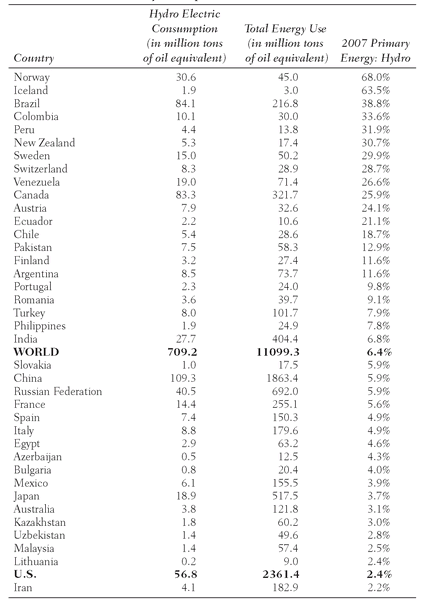
Source
: BP Statistical Review of World Energy 2008,
http://www.bp.com/liveassets/bp_internet/globalbp/globalbp_uk_english/reports_and_publications/statistical_energy_review_2008/STAGING/local_assets/downloads/pdf/statistical_review_of_world_energy_full_review_2008.pdf
.
: BP Statistical Review of World Energy 2008,
http://www.bp.com/liveassets/bp_internet/globalbp/globalbp_uk_english/reports_and_publications/statistical_energy_review_2008/STAGING/local_assets/downloads/pdf/statistical_review_of_world_energy_full_review_2008.pdf
.
APPENDIX E: U.S. AND WORLD PRIMARY ENERGY CONSUMPTION, BY SOURCE, 1973 AND 2008
TABLE E.1
U.S. and World Primary Energy Consumption, by Source, 1973 and 2008
U.S. and World Primary Energy Consumption, by Source, 1973 and 2008
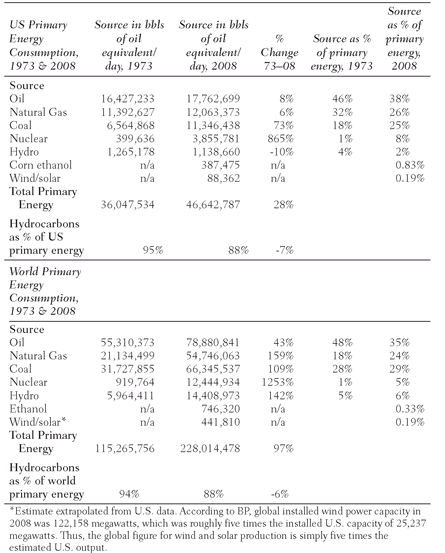
Sources
: BP Statistical Review of World Energy 2009,
http://www.bp.com/liveassets/bp_internet/globalbp/globalbp_uk_english/reports_and_publications/statistical_energy_review_2008/STAGING/local_assets/2009_downloads/renewables_section_2009.pdf
. For ethanol data, see Renewable Fuels Association, “Statistics,”
http://www.ethanolrfa.org/industry/statistics/
. For U.S. wind and solar data, see Energy Information Administration, Table ES1.B, “Total Electric Power Industry Summary Statistics,”
http://www.eia.doe.gov/cneaf/electricity/epm/tablees1b.html
.
: BP Statistical Review of World Energy 2009,
http://www.bp.com/liveassets/bp_internet/globalbp/globalbp_uk_english/reports_and_publications/statistical_energy_review_2008/STAGING/local_assets/2009_downloads/renewables_section_2009.pdf
. For ethanol data, see Renewable Fuels Association, “Statistics,”
http://www.ethanolrfa.org/industry/statistics/
. For U.S. wind and solar data, see Energy Information Administration, Table ES1.B, “Total Electric Power Industry Summary Statistics,”
http://www.eia.doe.gov/cneaf/electricity/epm/tablees1b.html
.
NOTES
Author's Note1
Shannon Hale, “Write What You Don't Know,” Squeetusblog, December 10, 2008,
http://oinks.squeetus.com/2008/12/write-what-you-dont-know.html
.
IntroductionShannon Hale, “Write What You Don't Know,” Squeetusblog, December 10, 2008,
http://oinks.squeetus.com/2008/12/write-what-you-dont-know.html
.
2
Energy Information Administration, Table 9, “Major U.S. Coal Mines,”
http://www.eia.doe.gov/cneaf/coal/page/acr/table9.html
; author communication with the mine's general manager, Eric Anderson, via e-mail, March 2, 2009. According to Anderson, the mine produced 5.75 tons of coal per employee per hour in 2008.
Energy Information Administration, Table 9, “Major U.S. Coal Mines,”
http://www.eia.doe.gov/cneaf/coal/page/acr/table9.html
; author communication with the mine's general manager, Eric Anderson, via e-mail, March 2, 2009. According to Anderson, the mine produced 5.75 tons of coal per employee per hour in 2008.
3
In 2007, the average for underground coal mines was 3.34 tons per employee per hour. Energy Information Administration, Table 21, “Coal Mining Productivity by State and Mine Type,”
http://www.eia.doe.gov/cneaf/coal/page/acr/table21.html
.
In 2007, the average for underground coal mines was 3.34 tons per employee per hour. Energy Information Administration, Table 21, “Coal Mining Productivity by State and Mine Type,”
http://www.eia.doe.gov/cneaf/coal/page/acr/table21.html
.
4
Eric Anderson, interview with author, February 20, 2009. In 2008, the mine produced 5.6 million tons of coal. That's 15,342 tons per day.
Eric Anderson, interview with author, February 20, 2009. In 2008, the mine produced 5.6 million tons of coal. That's 15,342 tons per day.
5
A barrel of oil contains approximately 5.8 million Btu. Energy Information Administration, “Energy Calculators,”
http://www.eia.doe.gov/kids/energyfacts/science/energy_calculator.html
.
A barrel of oil contains approximately 5.8 million Btu. Energy Information Administration, “Energy Calculators,”
http://www.eia.doe.gov/kids/energyfacts/science/energy_calculator.html
.
6
Energy Information Administration, Table 1.1.A, “Net Generation by Other Renewables: Total (All Sectors),”
http://www.eia.doe.gov/cneaf/electricity/epm/table1_1_a.html
.
Energy Information Administration, Table 1.1.A, “Net Generation by Other Renewables: Total (All Sectors),”
http://www.eia.doe.gov/cneaf/electricity/epm/table1_1_a.html
.
7
Converting electricity to oil terms is a straightforward calculation: One barrel of oil contains the energy equivalent of 1.64 megawatt-hours of electricity. Thus, 52,869,000 megawatt-hours, divided by 1.64 megawatt-hours (the amount per barrel of oil) = 32,237,195 barrels of oil equivalent from wind and solar for all of 2008. Dividing those 32,237,195 barrels of oil equivalent by 365 days (to determine daily energy production) gives us 88,321 barrels of oil equivalent per day from all solar and wind power generation in the United States.
Converting electricity to oil terms is a straightforward calculation: One barrel of oil contains the energy equivalent of 1.64 megawatt-hours of electricity. Thus, 52,869,000 megawatt-hours, divided by 1.64 megawatt-hours (the amount per barrel of oil) = 32,237,195 barrels of oil equivalent from wind and solar for all of 2008. Dividing those 32,237,195 barrels of oil equivalent by 365 days (to determine daily energy production) gives us 88,321 barrels of oil equivalent per day from all solar and wind power generation in the United States.
8
Eric Anderson, interview with author, February 20, 2009. Wind-capacity data is from American Wind Energy Association, “Wind Energy Grows by Record 8,300 MW in 2008,” January 27, 2009,
http://www.awea.org/newsroom/releases/wind_energy_growth2008_27Jan09.html
.
Eric Anderson, interview with author, February 20, 2009. Wind-capacity data is from American Wind Energy Association, “Wind Energy Grows by Record 8,300 MW in 2008,” January 27, 2009,
http://www.awea.org/newsroom/releases/wind_energy_growth2008_27Jan09.html
.
9
I would like to thank Tulsa-based professional land surveyor Chris Cauthon for his tutorial on Points of Beginning. See also Andro Linklater,
Measuring America: How the United States Was Shaped by the Greatest Land Sale in History
(New York: Plume, 2002), 2.
I would like to thank Tulsa-based professional land surveyor Chris Cauthon for his tutorial on Points of Beginning. See also Andro Linklater,
Measuring America: How the United States Was Shaped by the Greatest Land Sale in History
(New York: Plume, 2002), 2.
10
Central Intelligence Agency, World Factbook, “North America: United States,”
https://www.cia.gov/library/publications/the-world-factbook/geos/us.html#Econ
.
Central Intelligence Agency, World Factbook, “North America: United States,”
https://www.cia.gov/library/publications/the-world-factbook/geos/us.html#Econ
.
11
See Van Jones,
The Green Collar Economy: How One Solution Can Fix Our Two Biggest Problems
(New York: HarperOne, 2008), and Greenjobs,
http://www.greenjobs.com//files/22/38/63/f223863/public/index.aspx
. For Obama's statement, see his energy platform, available at
http://my.barackobama.com/issues/newenergy/index.php
.
See Van Jones,
The Green Collar Economy: How One Solution Can Fix Our Two Biggest Problems
(New York: HarperOne, 2008), and Greenjobs,
http://www.greenjobs.com//files/22/38/63/f223863/public/index.aspx
. For Obama's statement, see his energy platform, available at
http://my.barackobama.com/issues/newenergy/index.php
.
12
For more on the corn ethanol scam, see my book
Gusher of Lies: The Dangerous Delusions of “Energy Independence”
(New York: PublicAffairs, 2008).
For more on the corn ethanol scam, see my book
Gusher of Lies: The Dangerous Delusions of “Energy Independence”
(New York: PublicAffairs, 2008).
13
The International Energy Agency puts recoverable global gas resources at 850 trillion cubic meters. See IEA,
World Energy Outlook 2009
, Executive Summary, 49. A cubic meter contains 35.3 cubic feet.
The International Energy Agency puts recoverable global gas resources at 850 trillion cubic meters. See IEA,
World Energy Outlook 2009
, Executive Summary, 49. A cubic meter contains 35.3 cubic feet.
Other books
When the Heavens Fall by Marc Turner
Easterleigh Hall at War by Margaret Graham
What We Search For by Stories, Natasha
The Descent From Truth by Greer, Gaylon
shift happens 03 - no were to run by peterman, robyn
When One Man Dies by Dave White
Her Christmas Bear by Marie Mason
Plastic Smile (Russell's Attic Book 4) by Huang, SL